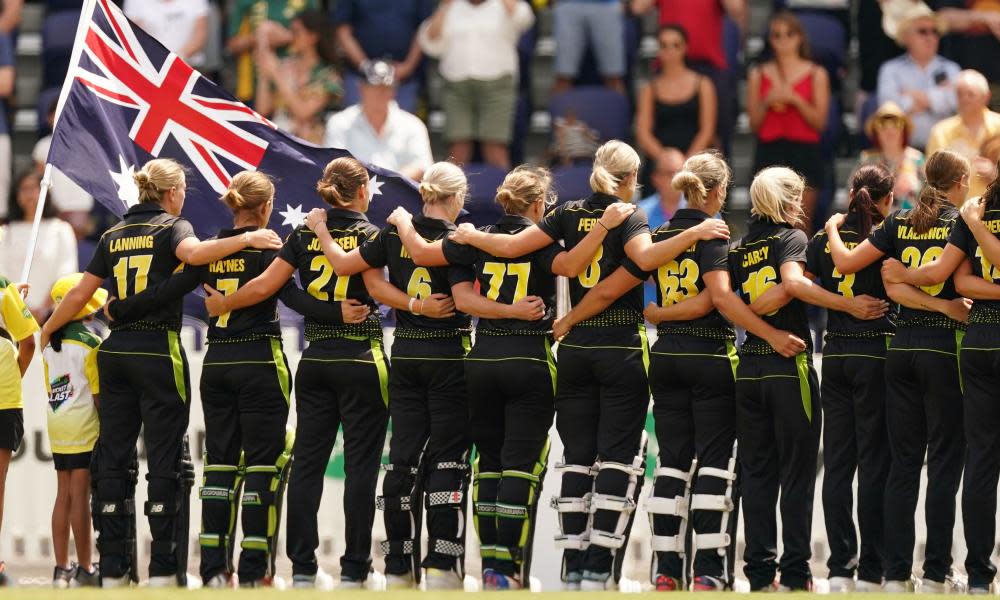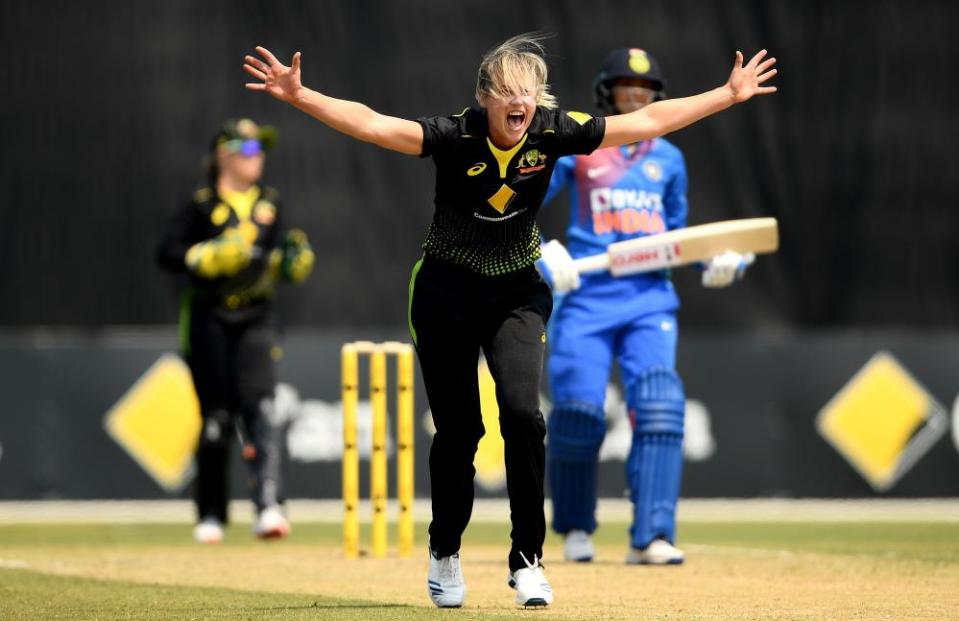Pressure of Women’s T20 World Cup favouritism looms as Australia's fiercest foe

Pressure does the strangest things. It melts the coolest of heads, obscures the most obvious move or turns the ball to liquid as hands close around it. Players say they thrive on it, that it brings out the best in them and sometimes they are right. And often wrong.
Pressure is hard to quantify and unknown pressure is difficult to prepare for. And it is the pressure of being the overwhelming favourites in a home World Cup, the biggest of its kind, that provides the unknown opponent for Australia in the month ahead. They’ve never been to this party.
Related: England in the running to upset Australia in Women’s T20 World Cup
Put simply, Australia have the strongest team with the greatest depth and easily the most abundant resources and investment. In the past two years they have won 26 out of the 31 Twenty20 internationals they have played; only England and India have bested them. And yet, the fact two of those losses came in the tri-series that preceded this T20 World Cup will give others hope that cracks could be exploited, perhaps widened, by the weight of expectation.
Reports have zeroed on opener Alyssa Healy’s meagre returns from three innings in the tri-series – she made scores of 9, 1, 0, 1 and 4 – but her partner at the top, Beth Mooney, generally ensured Australia’s good starts. The pair sometimes seem to trade form and it is worth remembering that before Australia’s victorious 2018 T20 World Cup in the Caribbean, Mooney was piling up runs while Healy struggled. Mooney went on to have a modest competition while Healy flayed her way through attacks, made 225 runs at an average of 56.25 and was named player of the tournament.
That kind of record sums up why Australia feel licensed to attack and take risks with their batting. There is nearly always someone else to grab the baton. Meg Lanning, Rachael Haynes and Ellyse Perry provide experience and stability when consolidation is required, without sacrificing scoring rates, and the explosive power of Ash Gardner can blow an innings open. Even the least experienced player in the squad, Annabel Sutherland, displayed a clear mind and clean striking as she recently plundered 22 runs from 11 balls to take Australia into a super-over against England.

It’s no surprise Australia’s aggressive, front foot approach calls to mind the England men’s World Cup winning ODI side; coach Matthew Mott has worked extensively with former England mentor, Trevor Bayliss, at New South Wales and shares some of his white ball philosophies.
Related: Tri-series exposed Australia's flaws but lessons can be learned for T20 World Cup | Megan Schutt
If the batting fails to fire as it ought, Australia’s bowling attack in home conditions has the depth and variety to threaten, contain and run through any side. Megan Schutt’s canny swing has made her the No 1 ranked T20 bowler in the world and Tayla Vlaeminck’s raw pace and bounce brings serious excitement. Her fastest bouncers – not often seen in women’s cricket – can surprise even the best batters and force a top edge; if the pitches are pace friendly she will undoubtedly bang them in hard.
But perhaps the most encouraging sign for Australia lies in the form of their left-arm spinning allrounder, Jess Jonassen. A knee knee injury kept her on the sidelines during the last T20 World Cup but she has been a mainstay of the attack since returning to the side for last year’s Ashes campaign and took a career-best five for 12 in the tri-series final against India, bowling at the death against a side that is easily one of the best against spin.
Mott and Lanning have other options, depending on conditions and even specific match-ups. Georgia Wareham has emerged as Australia’s leading attacking leg-spinner while Nicola Carey and Delissa Kimmince offer medium pace and lower-order flair with the bat. Erin Burns offers off-spin to complement her batting but it is hard to see her forcing her way into such a formidable side early on in the tournament.
And then there is Perry. It’s hard to find new ways to describe a player who has already worn all the superlatives and whose extravagant talent makes the extraordinary seem everyday. Here, indeed, is a player who has always risen in the face of pressure. But you can’t say it transforms her into a diamond; that would assume she was once a lump of coal instead of the supreme athlete she has always been, a frankly ridiculous notion.
Related: Shafali Verma: the teenage sensation aiming to fire India to Twenty20 glory
Perry’s T20 batting skills, particularly her power-hitting and strike rate, have flourished in recent years but it is worth remembering what was arguably her finest bowling spell during the 2013 World Cup final against West Indies in Mumbai. An ankle injury had kept her out of the Super Six stage and she had not fully recovered when Australia gambled on her selection in the final. After a key contribution with the bat, Perry, clearly in pain, pulled out of her run-up twice and hobbled back to her mark before taking three vital wickets and conceding eight runs in six overs. Australia lifted the trophy. If Mott could bottle what drove Perry on that day, it would be passed around the players for pre-match swigs, starting on Friday against India.
Each World Cup starts with a fresh slate, ready for new tales of sporting heroism. And, of all the formats, T20 is the most unpredictable; one brilliant innings, one scything spell, one dazzling moment of athleticism in the field can turn the game against even the best team. Not to mention that intangible, elusive, unquantifiable notion of pressure.


